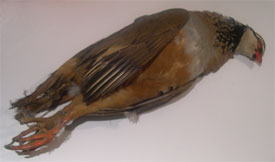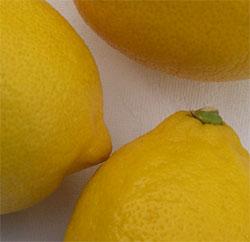How to pluck and draw game: a partridge or pheasant.
Posted by Fiona Nevile in Basics, Pheasant and Game | 80 comments Game is a treat. We don’t shoot and I don’t know many people who do. Hero of the kitchen garden, John Coe, is a beater during the winter months and sometimes brings us a brace of pheasant. His presents are always hung and dressed, ready for the pot.
Game is a treat. We don’t shoot and I don’t know many people who do. Hero of the kitchen garden, John Coe, is a beater during the winter months and sometimes brings us a brace of pheasant. His presents are always hung and dressed, ready for the pot.
Occasionally we’re given a brace of pheasant or partridge, complete with feathers Until today, I have hung, skinned and drawn them, and then cooked them slowly, enclosed in a casserole. Now I know how to pluck a bird. By keeping the skin our repertoire of recipes has increased tenfold. The skin contains fat and makes for a more succulent bird. Roasting is now a possible option.
I’m working at a lovely house in Upend at the moment. Yesterday Carol and Patrick gave me a brace of partridge. I was delighted and spent a happy split second planning how to cook them. As I skin my game the Romanian way, there is only one recipe that really suits game prepared in this way. It’s mouth watering and will appear on this blog after Christmas. Update: 27 January 2007, we have now developed two more exellent recipes for skinned game. Check out the recipes section of the blog.
I was always a bit envious of people who could pluck game, imagining it to be a complex and fiddly procedure. Today I discovered that it’s not. When Patrick found out that I didn’t know how to pluck a bird he immediately volunteered to give me a lesson. He rustled up a carrier bag; I grabbed the birds they had given me. Patrick demonstrated and within minutes I was plucking my first bird. The plucking is straightforward. Dealing with fluttering feathers is not. Hence the carrier bag.
How to hang, pluck and draw a partridge or pheasant
- Hang the bird for a couple of days (by the neck) in a cool place such as a garage or cold larder.
- Cut off the head at the base of the neck with a decent pair of scissors. (Once you have got rid of this the whole procedure seems less ghoulish).
- snap the lower legs at the joints and pull out the tendons. This takes some strength.
- Cut off the wings at the joint. (you will find this in the fold between the wing and the body.)
Plucking the feathers:
It is easier to pluck a bird when it is warm. Let a bird reach room temperature before plucking, it makes an enormous difference
- Find a carrier bag (any supermarket one will do)
- Stand your carrier bag on a table, workbench, or in the sink (I use the sink) the bird will be plucked into this. Pull up the sides of the carrier bag so that you have an enclosed area in which to contain the plucked feathers.
- Put a few sheets of newspaper around your working area to catch any stray feathers.
- Hold the bird by the legs and brush the feathers on the breast and back (against the grain, so to speak) so they sit up a little. With small neat movements pluck the feathers away and down from the bird, ideally straight into the carrier bag.
If skin comes away on the base of the feathers you are being too rough or trying to remove too many feathers at once. Experiment a little with this. You will soon get the feel of the most efficient plucking movement. I place my fingers on the skin around the plucking area.this stops the skin being plucked from the carcass along with the tips of the feathers. - Spread the tail feathers into a fan shape and pluck these following the line of the feather.
- To remove the leg feathers, hold the body and brush the feathers smooth (with the grain) and pluck them sharply down in that direction.
Another friend sits down to pluck a bird, with a dustbin liner between her knees. The feathers are plucked with a short downwards movement, straight into the bag. It’s worth experimenting with different plucking methods to find one that suits you best. I find that some feathers are more easily removed ‘against the grain’ and some ‘with the grain’. The secret is in the short precise plucking movement. If you can get into a relaxed rythm it’s easy.
Drawing the bird
- Remove the crop (from the head end) by gently putting a finger into the neck opening, rotating gently and pulling the crop out. If you are curious, you can open this to see what the last meal was. Remove the gullet and windpipe.
- Now stick your forefinger up the birds bum. Rotate it gently and draw out the liver and guts. We freeze the livers to use in an excellent terrine.
- Wash the bird (inside and out) and refrigerate for a couple of days before use.
If your bird smalls bad chuck it away, contained in a couple of tightly sealed carrier bags. Sometimes gun dogs will pick up a lost bird from a day or so before. This is rare but it has happened to us.
Skinning a bird:
Follow the steps for ‘How to hang, pluck and draw a partridge or pheasant’ then put your finger under the skin around the neck and loosen the skin. Hold the skin firmly and pull gently down towards the tail. The skin and feathers should come off in one piece. Once skinned, don’t forget to draw the bird (see above). Roasting is really out if you have skinned your bird but any casserole or recipe that encloses the bird will probably be sucessful. See our pheasant recipes, these were all cooked with skinned game and are excellent.
Leave a reply






just spent an enjoyable hour or so plucking a brace of pheasant for dinner, wondered why you put your pheasant in the fridge for a coupleof days before eating?
have been on the boxing day shoot and shot a brace of pheasant, a brace of partridge and a woodcock, thank you very much as i have been able to successfully prepare the birds and have eaten them after four days hanging, i can assure you they where delicious and i cant wait till the next shoot
thank you for your help and understanding
will siddons …
Hi Will
Yes, a small slit would be a good idea. Sometime if the bird has been shot there will be a hole in the breast of the bird (I always check for this first). You need to go in from the other end too, to draw out the entrails. When all is done a good rinse will sloosh out the insides.
hiya, im good with plucking and gutting the pheasants (despite my mum wont let me have them near the house so i have to warm them up with an electric heater in the garage) i just get really stuck when it comes to removing the crop, once i have cut of the head at the base of the neck do i cut a small slit down towards the breast to enable me to efficiently remove everything?
Thank you very much indeed any help will be very much appreciated as i love eating game just havent quite got the preperation stage yet
will siddons
Hi Ian,
Thank you for raising these queries.
The crop is a little sac at the base of the neck, where it joins the trunk. I have changed the article to explain that you chop off the head “and neck”.
We used to hang game birds for 7 days but when we developed “pheasantitis”, we reduced that to just 3 days. Hanging tenderises the meat and enhances the gamey flavour. But too gamey can be offputting so we now think 3 days is best.
Yes, do ask the buthcher but any butcher would not sell game that has not been hung for 3 days at least. Staff might not know the answer anyhow so don’t worry. Assume 3 days. The pheasant that you buy at the butchers or supermarket are oven ready.
Hanging, drawing and plucking a pheasant means that you are more in control.
On the hanging front. If the weather is very cold (frosty and snowy) you may need to hang the pheasant for longer.
hi again, should I also ask the butcher when they were shot and how long they’ve already been hanging? thanks!
Hi , thinking of purchasing a brace of pheasant and wanted to check what the “crop” was, do you chop head of first? not done this before so don’t know, also do you hang for just 2 or 3 days, as i’ve also heard to hang for up to 7 days
Hi
A guy across the road from me game me 3 pair (1 pair at a time) of peasant last winter and each time he did this I did not have the guts to do it. HOwever, got another pair this morning – I walked out of the house and straight into them hanging from my porch! I have successfully plucked and gutted them and they are sitting in my fridge! Albeit they lost a bit of skin in the process so will warm them up next time and see if that works! Thank you so much for the info. Fi
Hello Mark
Thanks for your reassuring remarks about the green!
Great idea using parma ham, must try this next time that I get hold of a partridge.
Hi Dave
Yes the drawing the birds is the nasty bit! But great that you found the instructions useful.
Hi ya
Thanks for the instructions, first time i have done this, but again with your help a great success. Not too keen on the inerds.
Thanks